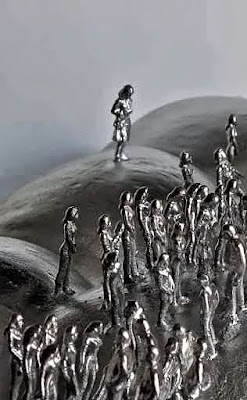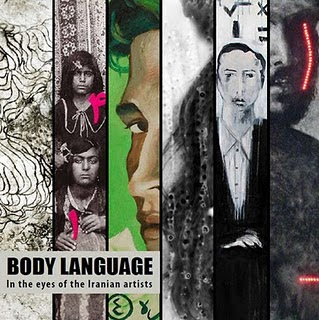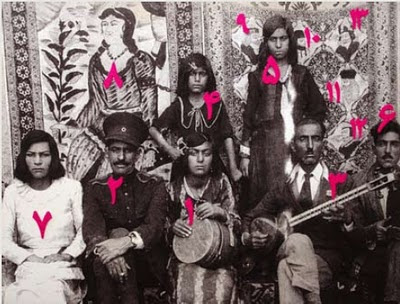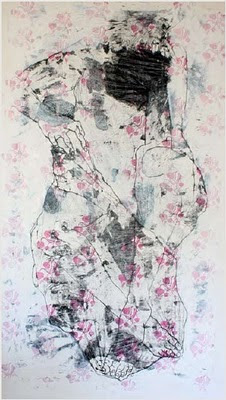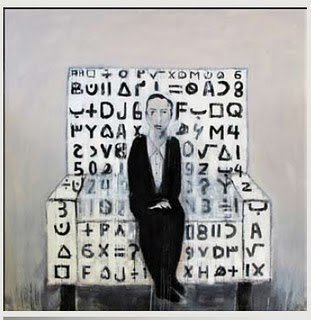A preformance of "Come Caress Me, September 2010" at the Azad Art Gallery in Tehran. In the exhibition, Amir Mobed, an artist, invited visitors to shoot him with a pellet gun.
The paradoxes of Iran are visible at the Museum of Contemporary Art, designed by the Iranian artist and architect Kamran Diba as an inverted version of the Guggenheim Museum in New York.
In the central atrium hangs an Alexander Calder mobile bought for the museum’s inauguration, in 1977, two years before the Islamic Revolution. To the right is an untitled 1966 sculpture by Donald Judd consisting of a vertical array of nine panels of what the wall label describes as “galvanized iron” stacked from floor to ceiling.
The Judd, probably worth $5 million today, is just one of hundreds of Impressionist, modern, and contemporary artworks acquired at the institution’s founding. But it and the Calder are among the few Western pieces still on view; the rest, including works by Monet, Van Gogh, Pissarro, Renoir, Gauguin, Toulouse-Lautrec, Magritte, Miró, Braque and Pollock, are buried in storage. A close look at the Judd sculpture reveals scratches and solvent stains on several of the panels, which are spaced unevenly on the wall and fixed badly — some askew.
Until the revolution, Iran was among the most cultured, cosmopolitan countries in the region. It had a progressive movement in art and literature and a sophisticated film and television industry. The mostly Shiite Muslim population was pious but not fanatical.
“We used to drink in public and pray in private, but today we pray in public and drink in private,” said my guide, who has an engineering degree and whose job was to accompany me everywhere, reporting on my movements.
Having him around was a condition of my entry into a country where foreigners are largely unwanted and unwelcome. Officially, Iran reports that it receives around 10,000 tourists annually, a staggeringly low number considering its cultural attractions; Persepolis, capital of the Achaemenid Persian Empire, is one of the great archaeological sites in the region. Dubai, with little to offer beyond shopping and an annual art fair, gets about a million visitors a year.
These are anxious times for artists in Iran. Some have simply decided to remain outside the country.
In spring 2009, the brothers Ramin and Rokni Haerizadeh were en route to Tehran after a brief trip to Paris for their first show at Galerie Thaddaeus Ropac when, according to an interview published recently in Wmagazine, “they got a call from a friend warning them not to return home.” Their work had been confiscated during a raid on the home of a Tehran collector, and it was feared that they would be arrested. The brothers applied for residency in the United Arab Emirates and now live in Dubai.
Culture is valued here. There are numerous public theaters, museums, galleries and both public and private art schools in Iran. The country annually turns out about 40,000 art-school graduates, including graphic artists. But since the end of Mohammad Khatami’s relatively liberal presidency in 2005, numerous artists, editors, writers, and filmmakers have been jailed.
According to Hamid Keshmirshekan, editor in chief of Art Tomorrow, a new Iranian contemporary art magazine, Tehran has more than 60 private galleries — 100 if you include all the “public” spaces — spread around the city but mostly clustered in the wealthier northern suburbs. Many are in private houses, so the scene has an ad hoc feel. A handful of private individuals back the arts. Most gallery owners are women, as they are elsewhere around the world.
In the course of my stay in Tehran, I visited about a dozen galleries, met many talented artists and saw daring and progressive work. The good news is that Iranian art is alive and well. The bad news is that so much of the work cannot be shown publicly, or can be exhibited only for a few hours during an opening before being whisked into storage.
The Ministry of Islamic Culture and Guidance keeps a tight rein on what can and cannot be displayed, and every gallery owner I met had a story about being called in to the ministry and asked to explain and subsequently remove the artworks on their walls. Pieces deemed offensive or blasphemous expose dealer and creator to prosecution.
Younger artists are especially daring. Many of them employ humor as a weapon in their work, obliquely poking fun at the ruling clique of mullahs or pointing out the absurdities and contradictions of contemporary life in Iran. It is at once heartening and unnerving to see these young people embracing art-making as a mode of protest.
In April, several Tehran galleries hope to stage an impromptu joint exhibition of about 70 artists’ works devoted to flower imagery, an act of solidarity with Mehraneh Atashi, a photographer who was detained in January 2010 for documenting Tehran’s street protests. She was released on the condition that she start taking pictures of something more suitable, like the beauty of local horticulture.
Indeed, photography has emerged as a particularly vital means of social and political engagement. Shirin Aliabadi and Shadi Ghadirian are known for exploring women’s issues in Iranian society. Both have exhibited abroad, and their work is in American and European museum collections. Ms. Ghadirian has recently established an Internet registry of Iranian photographers, fanoosphoto.com, which presents online exhibitions.
The photojournalists Abbas Kowsari and Newsha Tavakolian, who live in Tehran, have had some success exhibiting and selling in and outside the country. Mr. Kowsari likes to portray Iranian society’s absurdities; his images of chador-clad female police cadets valiantly rappelling down the sides of public buildings in Tehran are now famous. Then there is Arash Fayez, 27, a promising young photographer who received some attention at the last Paris Photo fair. For his recent series “Decadence of Memories,” he shot five Polaroids of favorite childhood relics (including a ball and a sauce bottle in the shape of a bear) against the backdrop of Tehran’s crumbling urban landscape, summoning the faded dreams of his youth.
Nazila Noebashari, a collector, opened Aaran gallery on the second floor of a family-owned building in central Tehran two years ago. She has her office on the upper level, which doubles as the gallery storage. Artworks lean against walls, lie on makeshift shelves or rest on the floor among books. Ms. Noebashari is a curator as well, recently organizing a show of Iranian artists at the 18th Street Art Center in Los Angeles. Her gallery shows mostly younger and experimental artists and is one of the few in Tehran that is not overtly commercial.
When “Eshgh,” or “Love” — a Pop-style work in acrylic, Swarovski crystals and glitter on canvas by Farhad Moshiri — fetched $1.048 million at Bonhams Modern & Contemporary Arab, Iranian, Indian & Pakistani Art auction in Dubai in 2008, a proliferation of galleries began looking for ways cash in on a perceived growth market for Iranian works. But leading contemporary artists in Tehran, including Mr. Moshiri, refuse to exhibit with these galleries, who they say lack professionalism.
Another mode of expression that is popular among young, progressive artists is performance. Azad, established a decade ago by Rozita Sharafjahan and Mohsen Nabizadeh, the most avant-garde gallery in Tehran and a frequent venue for such pieces, is in a hard-to-find basement space with black-painted walls and a concrete floor in a quiet residential neighborhood. There, I met Amir Mobed, a 37-year-old conceptual artist. Mr. Mobed earned a name for himself with a performance at Azad, inspired by the American artist Chris Burden, in which he stood in front of a target with a protective metal box over his head and invited gallery visitors to shoot at him with a pellet gun. It was, he says, a symbolic execution, with a message about freedom of speech and the hopes of artists of his generation being silenced.
Most of the best art I saw contained guarded metaphors for national and social issues. Among the country’s emerging stars is Barbad Golshiri, the 29-year-old son of the late Iranian writer Houshang Golshiri. Barbad Golshiri’s powerful 2005 series of postcard-size photographs, “Civil War,” uses the many political, religious and commercial billboards around Tehran as none-too-subtle metaphors for the ideological conflicts at the heart of Iranian society.
An experience at the Silkroad Gallery perhaps best summarizes the perverse position of artists in Iran today. Perusing a portfolio of prints by Peyman Hooshmandzadeh, an artist and prize-winning writer (whose book was just banned), I paused at one showing young people in a Tehran cafe looking though a book of reproductions of photographs by Shirin Neshat, the Iranian expatriate contemporary artist. I asked the gallery owner, Anahita Ghabaian Etehadieh, why they are so interested in Ms. Neshat’s work.
“Because it has never been shown in her own country,” she replied.
Benjamin Genocchio is the editor of Art+Auction magazine.
Via NYTimes





